Several projects underway demonstrate interesting results
“Without maguey there is no mezcal” is a phrase often heard amongst the mezcal sipping community. The last decade has seen this community grow rapidly, drawing consumers that appreciate artisanal, organic and fair trade products.
Maguey (aka agave) is intertwined with Mexican culture. They are an iconic marker throughout the mountains and valleys from the most southern peninsular to the Northern deserts, and for thousands of years they have been used to make diverse products, pulque to paper to building materials and most recently”, mezcal.
Although mezcal should be synonymous with diversity, the ever growing demand and homogenization of flavor has led to the opposite, fields and fields of pure espadin. Fortunately, despite the concerning growth of espadin plantations, consumers invested in the culture of mezcal are looking for less common species, typically known as silvestres. Even mainstream publications such as the Washington Post and Bloomberg are starting to cover this development.
According to the CONAHYCT (Mexico’s entity in charge of the promotion of scientific and technological activities), there are more than 210 species of maguey worldwide, 75% are found in Mexico with quarter of the percentage being found in Oaxaca state. Most of these are used in mezcal production.
Historically mezcal production has depended on collecting plants from the wild. This work is laborious, expensive and inefficient. However, these wild varieties often produce mezcales with distinctive and highly sought-after flavors. This dynamic has led to many popular species becoming endangered from over harvesting (and deforestation), and finding a solution to this will never be straightforward.
Different takes on preserving wild agave
One reaction to the pressures on wild agave would be to restrict the use of rare agaves in mezcal production. My brother, gardening journalist Jonny Bruce, considers a solution would be to enforce protected zones where rare species are endemic. “As the demand for mezcal increases – particularly those distilled from rarer varieties – the onus is on the mezcal industry to not fuel the demand for these types through marketing/publicity.”
He thinks that “there should be a commercial ban on harvesting rare and slow growing varieties of agave in the wild.” However, it is unlikely there will be restrictions on harvesting rare species. But there are efforts being made to protect, grow and restore these wild species. This is through domestication.
There are various approaches to this work. Seed banks have been established in recent years to safeguard rare agave species. Research nurseries such as the gardens at Lalocura, Real Minero (Proyecto LAM) and Zinacantan are great resources of information about types of plants and their pollinators.

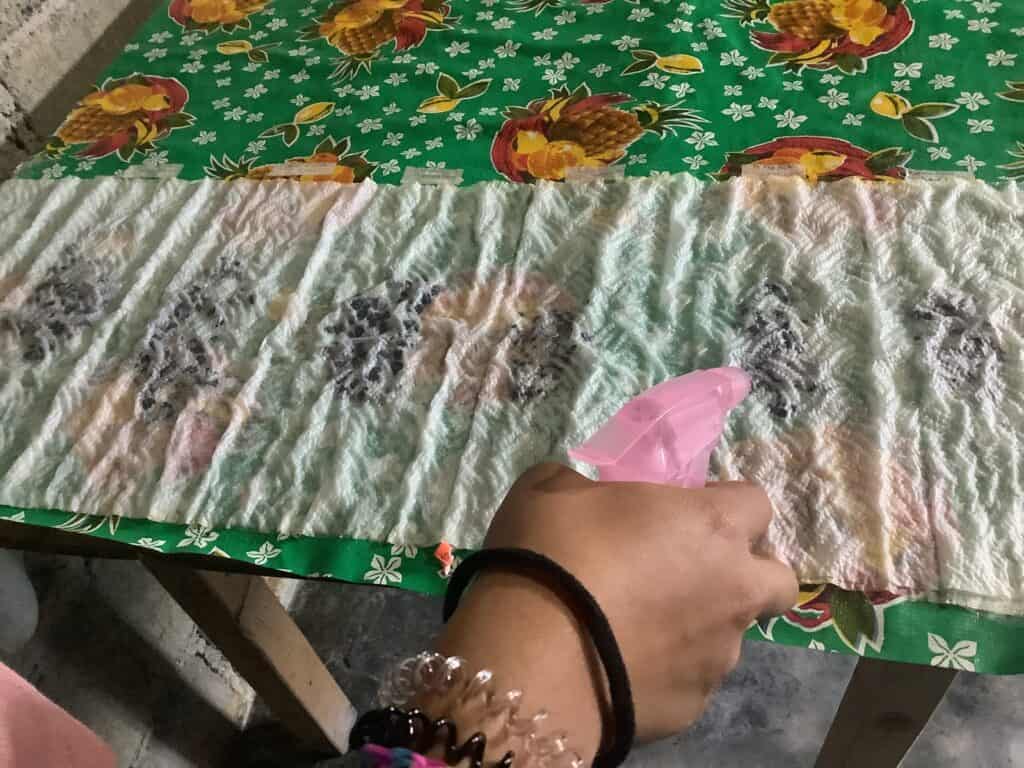
Del Maguey, now owned by Pernod Ricard, makes up a huge proportion of agave consumption. To offset this usage, in 2019 they began their wild agave project. Through this they produce tens of thousands of seeds from species including tobalá, tepeztate, cuishe and jabali.
In 2020, Del Maguey entered into an agreement with the Alfred Harp Helu Foundation to donate wild agave seeds. In return, they receive a percentage of the plants carefully grown from those seeds to be reintroduced in the natural environment. This work is actioned with consideration of the biodiversity of the region. Seeds are collected in communities in the Central Valley that have similar climates to where they will be planted. Since 2023, these nurseries’ management has been under the direction of COESFO.
According to Gabe Bonfanti (Del Maguey’s head of Sustainability and Responsibility) this initiative is to domesticate certain silvestre species and “ to reduce the stress on the environment.” He considers the principle challenges to be “how to plant them in a way that’s a little bit better for the environment than common espadin cultivation, and getting members of the community behind projects like this, because they do take a long time to grow.”
Positive outcomes include seeing more plants in the ground that can take the pressure off wild populations and allow wild varieties to flower and seed. Bonfanti shared that “Since 2019, we have donated 250,000 seeds and around 110,000 agaves have been donated to producers.

Douglas French, founder of Scorpion Mezcal, has been exploring the notion of “domesticating silvestres” since 1997. He employs single mothers from the local community to run the plant nursery. This is an initiative that his mother began when she came to Mexico in 1976.
French explains that “the reason we’re growing the plants is because they’re fading away. If you don’t grow plants or help them grow, they’re just going to go extinct.”
He says that in the nursery environment they have a good success rate growing from seed, particularly with silvestre species. However not all of the plants react how they expect. “Agricultural engineers explained to us that it’s five generations of working with your initial seeds to get them up to the point where they’re standardized.” However, I’ve got 20 years into Karwinsky’s and I don’t have control over it.”

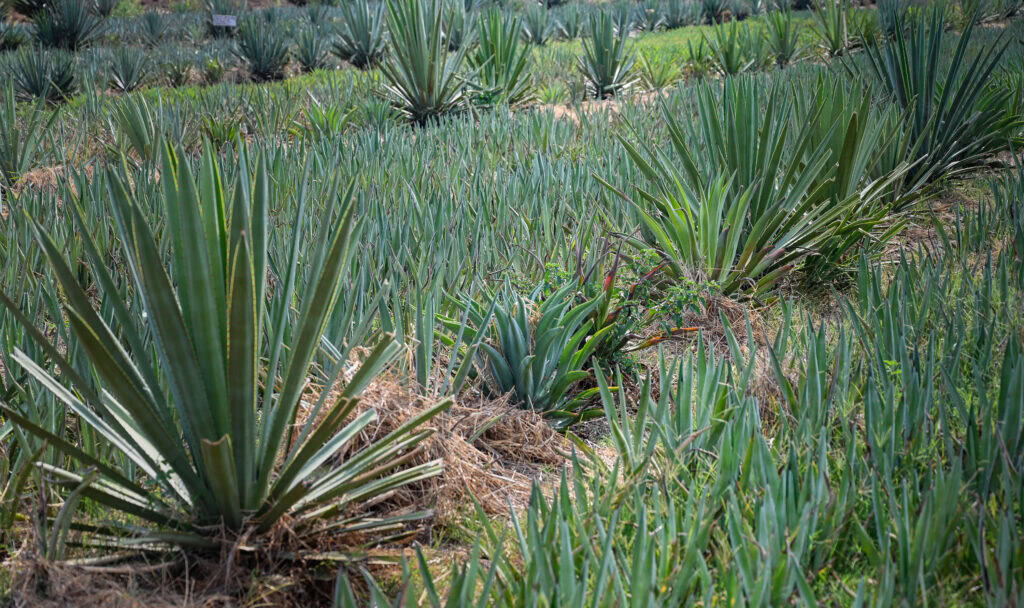


Case study: The Maguey Project
Grupo Los Danzantes has been producing mezcal for over 20 years with its Los Danzantes (Los Nahuales in the US) and Alipús brands. They highlight the work of producers, putting relevance on the source of the maguey, valuing terroir specific, wild and semi-cultivated maguey as a way of pursuing diversity.
In 2012 Los Danzantes began their “Maguey Project ” with Alipús mezcaleros and researchers from the Universidad Autónoma Chapingo, developing seedbeds of tobalá. This was to protect the future of the plant and to ensure enough capacity to deal with demand in the future.
Victor Perez is marketing manager for Danzantes and Alipús, working closely with the producers and university team involved in the Maguey Project. Recently Perez and agricultural engineer, Professor Efrain Paredes, showed me around the laboratory and plant nurseries at Chapingo University. Paredes leads the investigation into agave diversity issues.
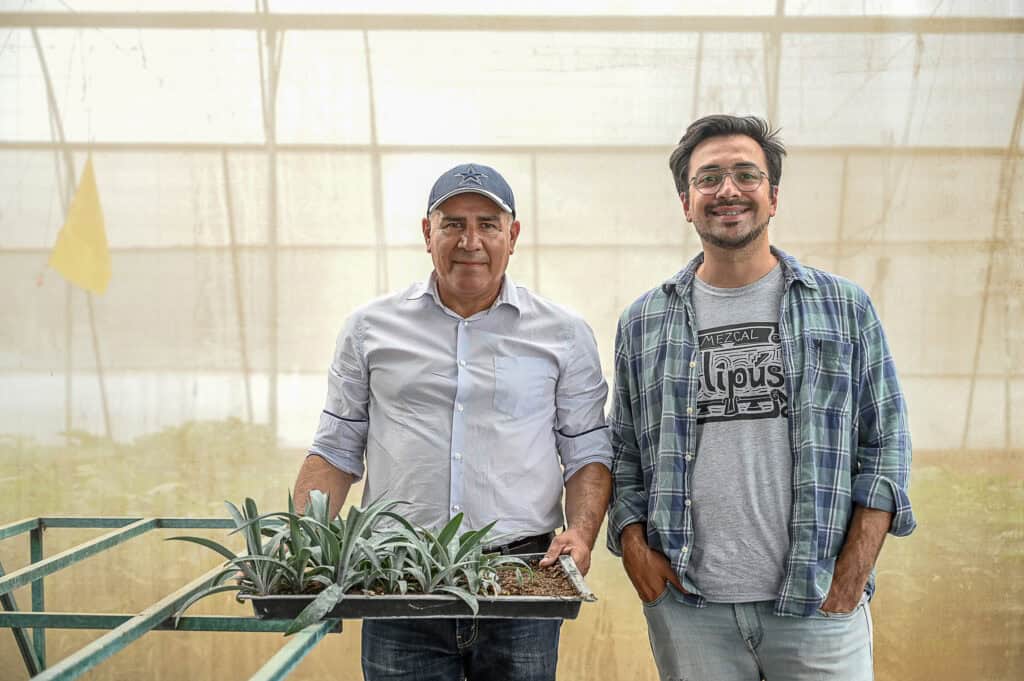
Before the Maguey Project, Danzantes only used wild agaves for special editions and limited batches. Perez remembers that “producers from Alipús would say: ‘hey, I have these 200 kilos of arroqueño. Would you like to use them?’ But that was the only time that Los Danzantes or Alipús used wild agaves.” tobalá was the only one used to make a regular product. “We basically produced one batch per year, about 300 bottles.”
However, “we started having problems because there weren’t any tobalás at some point, or at least no mature tobalás. We were looking in San Baltazar, San Juan, San Luis,Sola de Vega, where we work with producers from Alipús.”
This need to address the supply shortage led to the Maguey Project. “The project started developing at another level. We started noticing that not just tobalá was at risk, but also other agaves, especially mezcal producing agaves from the different areas where we source Alipús.”

Creating the first “shoots”
The team of Alipús and Danzantes noticed that the problem was more complex than first thought and that they didn’t have the knowledge to fully develop the project. So they joined forces with the Chapingo University, with support from CICY (Centro de Investigación Científica de Yucatán), who had previously been working with the hennequin plants and blue weber specifically.
Perez explains that “First we start doing just seeds, then hijuelos, and finally specifically with agaves that have particular problems with reproduction, such as not producing seeds or like a really, really small amount of seeds. Or the quiote died before they actually get the seeds or the flowers.”
They then work with a technique called micropropagation. This involves “ taking the center of the plant, the heart of the plant, and stimulating it with hormones, and vitamins” causing “sprigs” to form. The sprigs are similar to hijuelos in that they are genetically identical to the plant matter taken from the mother plant. They grow these shoots in the lab until it is time to put them in the greenhouse, the nursery and finally into the fields.

The lab at Chapingo University is small, built for research purposes, not commercial results. Paredes showed Perez and I how the agave shoots grow from the small piece of mother plant in their jars of hormone gel.
Paredes mentioned that they have noticed that the shoots that come from agaves that were already close to mature are different from shoots that come from younger mother plants. To the naked eye they look more purple for example. This reflects how the hijuelos coming off an older mother plant in the wild tend to be smaller.

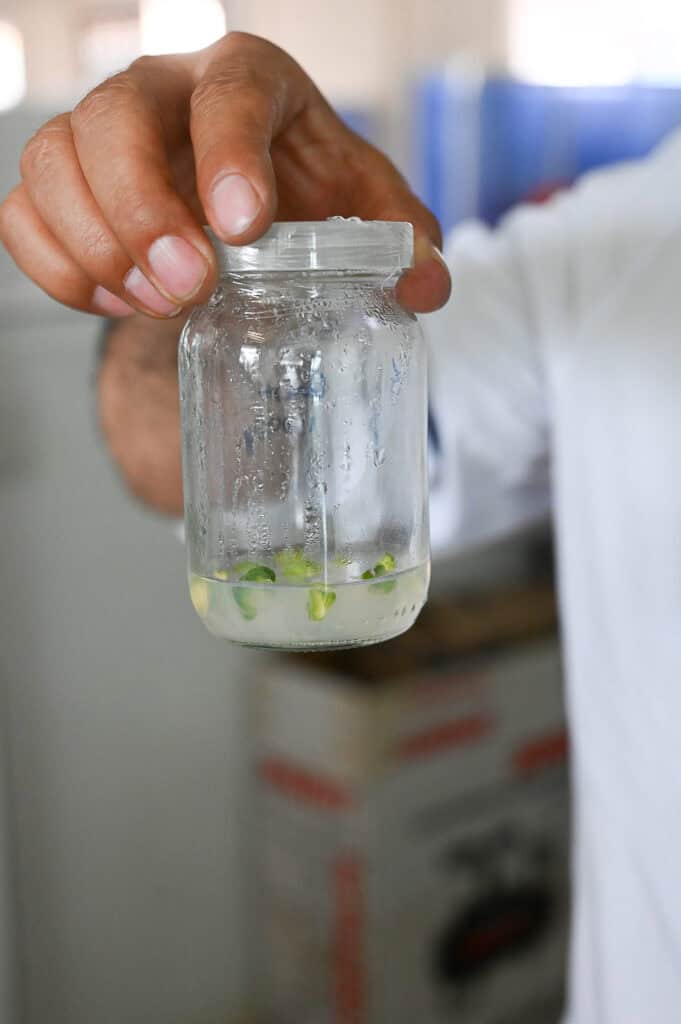


After visiting the lab we went out to the plant nursery where Paredes showed us how to plant individual seedlings from the lab. For this selection of tripon they planted trays of plants growing from seed and I am excited to say I now have a tray of tripon seedlings I planted on the record.
At the university they are experimenting with many variables. They change the amount of water that they use on each agave variety, the kind of soil that they have, the amount of plants per line, to understand what happens to each plant.
When the plants are transplanted to the field they are almost 2 years old and minimum 30 cm tall (1 foot). In Oaxaca, the cultivated maguey is grown in a low density (1800 plants per hectare) environment.




Realizations in the field – maintaining diversity
Instead of just using one agave or even only using agave in a line, they are using different species of agave in the same field, and they are using different species of plants. “For example, they are using corn, sunflowers, and squash. The milpa strategy,” in between the rows of maguey during the rainy season.
At the end of the project, 10% of the plants are left unharvested so that they can flower and reproduce by seed, in that way recovering genetic diversity.
Victor explains how they noticed “for example, in Miahuatlan, that when they just have espadins or just arroqueños in one field, they get plagues and pests more easily.” At one time they tried using fungicides and pesticides, but it worked better to introduce a mixed crop concept. Different agaves types have different physical profiles that can stop pests traveling between one and another.
While we were walking through the plant nursery, Paredes confirmed something I had previously heard from French and other maguey growers. Sometimes you can find different agave species growing from a single quiote’s seeds. To me it’s as though the plants themselves are clarifying the need to grow in diversity.

This approach to having a diverse number of species in a single area is the opposite of the monocrop agave concept that is threatening the landscapes of Mexico. As seen in the fields of Tequila, a plague can be 100% destructive in a field of cloned agaves.
Perez considers the growth of the mezcal industry to be a “bit like gentrification.Your love, my love for mezcal changed mezcal somehow. Big companies decide like, wow, people are really, really looking for this kind of stuff and I want to be part of that and sell bigger amounts.” To achieve these huge amounts of product requires the massive monocrops of espadin.
“The problem is not just about the domestication of the agave itself, but preservation of diversity. Every single area should have its own local agaves.” The problem with just having just one agave, like espadin being at least 90%” of domestic agave, is that the land cannot sustain that.”

On a more positive note, Perez describes a new development in certification in collaboration with the Chapingo university and the CRM. “They’re going to have a QR that states that producers have gone through sustainability practices. A bit like a certification of sustainability or organic certification. It is not official yet but the same will be something like “Sustainability Attributes”.
They began work on developing this “about four years ago, but of course, with the CRM, things stop and start”. But now they are nearly ready to make it official with the advisory support of experts at Chapingo University. “I think they recognize that it was a really, really important thing to do.”
“I think the CRM is going to send you all the information, such as what you need to do, to be available to have this recognition or this certification. After that they are going to go and check.”
“I don’t know if it’s going to cost extra, but obviously it’s going to cost extra to do the sustainability project practices, especially for brands or producers that don’t do it already.”
The other part is like, the CRM doesn’t have the resources or detailed knowledge to carry out the certification. “So, I think, the Chapingo University will go and check these practices.”
Importance of regionality in successful plantings
Perez describes how they “take plants from some specific areas, like, let’s say arroqueño from Sola de Vega. We reproduce them, then we send them back to their lands. But we also share agaves with other producers that normally don’t use that kind of agave because they didn’t grow it before.”
“There are some producers, for example from San Juan del Rio, who transported agaves (from the project at the lab) that don’t work in their lands. It is interesting for us because we’re thinking, wow, it’s not just about putting the agaves wherever.” The agave from specific areas grow more successfully in their original locale.
This was a major point covered at the recent Agave Heritage Festival. The overall consensus was that as wild agaves continue to be cultivated, regionality needs to be considered foremost. Agave, endemic to one regional environment, should be cultivated in that same environment.
According to Perez, Danzantes and Alipús now exports mezcal from “eleven different families from six different regions.” They regularly come together to have meetings about a specific topic. “Sometimes we talk about fermentation, sometimes we talk about distillation, the grinding machine, about the tahona, sometimes we even talk about taxation.…specific topics particular to the people.”
This is so that all the producers can understand what the differences are between each other, and if they can benefit from this knowledge. “I think it’s interesting for us and for them, because they exchange their information and techniques.”
In December 2022 Danzantes hosted this meeting at the Chapingo University site where the maguey project is developed, to discuss the first wave of agave harvested from the project. “Specifically coyote (Americana) and arroqueño,which are the more successful plants that we are working with.”
They talked about their different experiences cultivating the agave from the maguey project. Some producers struggled with plagues and fungi, especially when the terroir was very different from the original location. Others fortunately had great success with the agaves from the project. Growing “fast, high in sugar, easy to work with and full of flavor”.
With the Maguey Project they also began to study the particular diseases, such as the fungus common to arroqueño. “A lot of producers tell us that they don’t have the seeds of arroqueño because it gets sick before it actually flowers.”
“That was interesting because producers were also saying that the arroqueños are 15 years, 20 years old, but they had never actually seen them flower.” Because they harvest them before they ever produce a flower.
“The beautiful part about this project is that we have recognized a lot of new things.” For example Victor explains, books about agave always say arroqueño matures at 15 years old if not older. However, the plants grown at the research site “are eight, nine years old, and they are already mature, with really good levels of sugars.”
“We are cultivating arroqueños in different areas, not just for Los Danzantes, but every single producer of Alipús is growing their own arroqueño.” Perez says that the outcome of this has meant that some produce intense flavors while others are more simple. “Some arroqueños that are 15 years old and some others that are just this nine or eight years old are the same, as complex, as interesting.”
“For us what is more interesting than whether it’s wild or not is the terroir. The terroir concept. That’s the idea of mezcal Alipús since the beginning.”
“We have noticed that arroqueños that come from Sola de Vega, even if they are seven or eight years old, are going to be super different and complex, because of the kind of soil and the surroundings that they have. For example, they have a lot of pine trees, the other areas are really tropical.”
“What I wanted to say with this is that you can find mezcal that is not wild, whether it’s arroqueño or tobalá or something else, what we have noticed is that it’s going to change a lot depending on where it comes from.”
Victor also thinks the age of the finished spirit in glass is vital when attaining a fully realized quality mezcal. A domestic agave that has sat for several years in glass can be fantastic, compared to “a wild agave that it’s just produced last week that just tastes like alcohol, acidic and almost undrinkable.”
“It’s happening a lot now with the demand for mezcal.” Everything is too rushed. Victor remembers that “Before you used to go to the maestro mezcalero fair in Mexico City and every single mezcal was amazing. You could see from the labels that they were three, four, even five years old. Nowadays you go and the mezcal they are presenting was made just a few months before. You try them and it’s different, you know?”
Recently Danzantes have reached a point where they have enough of their own plants to use as a constant resource. At the moment, they have around 20 nurseries and have reproduced around 1 million plants since 2012 from 20 different species.
Therefore technically they have separated from CICY and the university in a working capacity. However, they still share information, and invite guests, like me, to visit the original university site to learn about the details of the Maguey Project.
It’s not just in Oaxaca
It is quite easy to be completely caught up in the issues of agave production and consumption in Oaxaca. However, the contemporary mezcal community is also curious to try agave varieties and production styles from other states. So as growth continues in these regions, approaching the idea of protecting and domesticating species in those areas will become increasingly relevant.
Sergio Garnier, founder of Ultramundo mezcal from Durango, has been planting maguey on his ranch in part to help with erosion of the land. He works with a species endemic to that land called Agave lamparillo, and the agave does grow wild in the region. However, he believes in preemptively cultivating the plant as well.
“I believe in semi-domestication protocol in order to preserve both: the agave and the endemic biodiversity around them. This essentially means helping the agave in the initial phases and then reintroducing them in a friendly way.”
In the case of Lamparillo we ‘help’ them by spacing out the clones of which they produce a lot and prevent them from getting enough water, nutrients, and space. We also collect seeds to germinate. The germination rate in the wild in our context of extreme weather is very close to zero.”
Sergio considers “the domestication of silvestre plants is irreversible as with most agricultural products for human consumption, but I am a strong believer in doing it the right way, in terms of methods that are friendly with the environmental context of the region and disrupt as little as possible the endemic biodiversity. I have no idea how certification could treat this, but I think they should provide all the detailed information for the consumer for a more educated decision. In the end it will all come to what they taste in their copitas.”

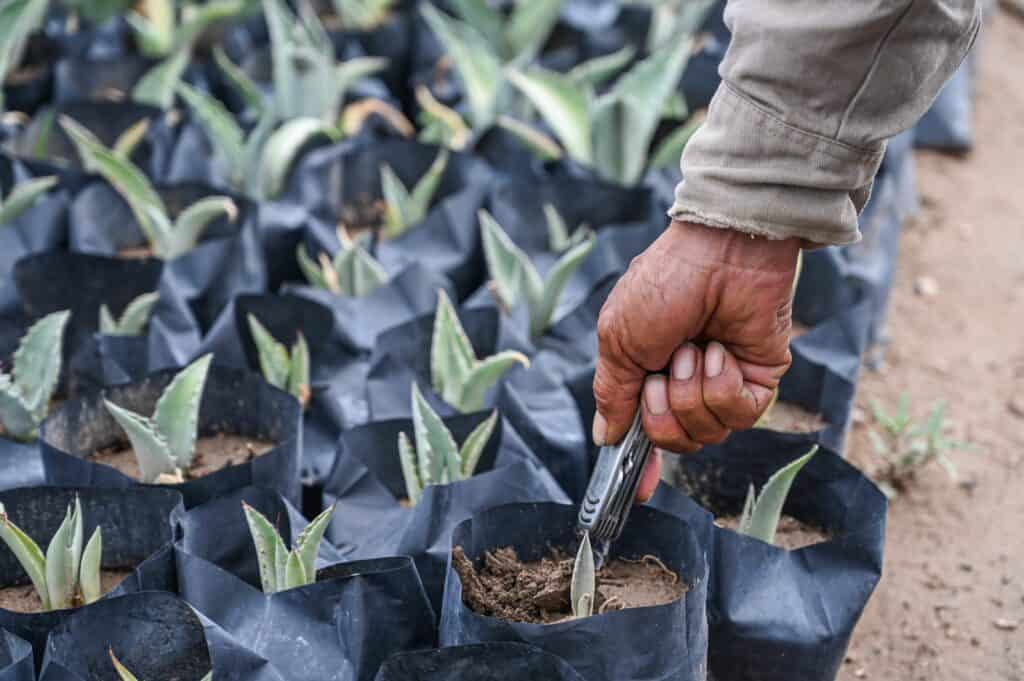
Domesticating silvestres for mezcal
Jon Darby of Sin Gusano argues that the very best mezcals are made with wild agave, where the Mezcalero has hand selected each plant for harvest at its optimal point of maturation: “You know when you’re walking around the countryside and can pick blackberries off a wild hedgerow, and they always taste better than the ones in the shop… that’s because you’re hand picking the ones that look best. Same with hand selecting wild agave for mezcal.”
However, Darby concedes that unfortunately this can only be done on a very small scale. “Arguably that’s how mezcal should stay. But it’s booming, so cultivation efforts are inevitable and necessary to keep up with growing demand.” His concern with domesticated agave is that “harvesting a whole field of hundreds or even thousands at exactly the same time is inevitably going to mean a variation in maturation points of these slow growing plants.”
My experience at Chapingo University broadened my knowledge and perspective around the issue of cultivating silvestre agave species. It was fascinating to hear how the research has led to a deeper dive into the significance of terroir, not just for plant health, but for sugar density and flavor profile. It made me more hopeful for the future of domesticated agave and how they influence the mezcal industry.
Diversity is a golden standard in conversations around sustainability, and diversity in the future of maguey is essential. Following the huge rise in the harvest of mezcal producing agave, how to sustain the biodiversity of these plants is now an important topic of research and development.
However, due to its long life cycle there has been minimal research into its genetic development, but this is one of the areas where there is focus and hope to protect the diversity of the genus. French explained that it takes around five generations to “domesticate” a species. Considering that some agave plants that can take a human generation to mature, we are still at the earliest stages of seeing what it means to domesticate them.
Whether the research is taking place in a university lab, in an overflowing plant nursery at a distillery or in the hills of an old ranch, there is so much to learn about agave. As Perez says, there is so much “love” for mezcal, at all stages from agave to glass. Hopefully this love and passion will translate into continued investment in a sustainable future.












Leave a Comment